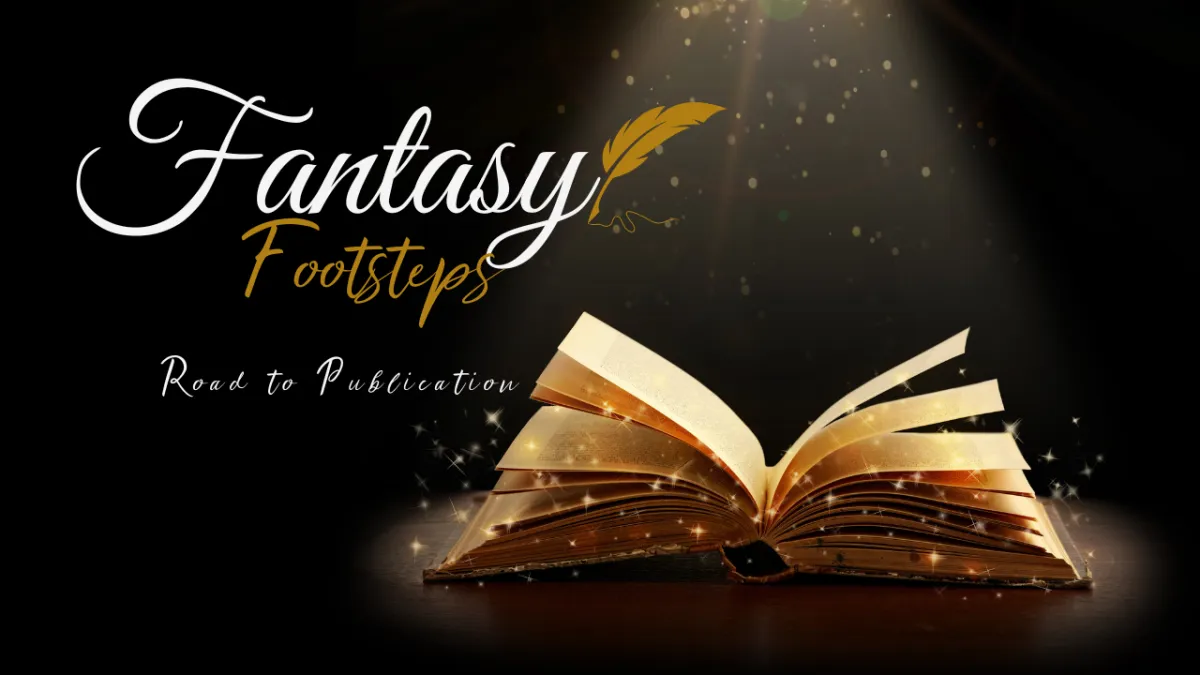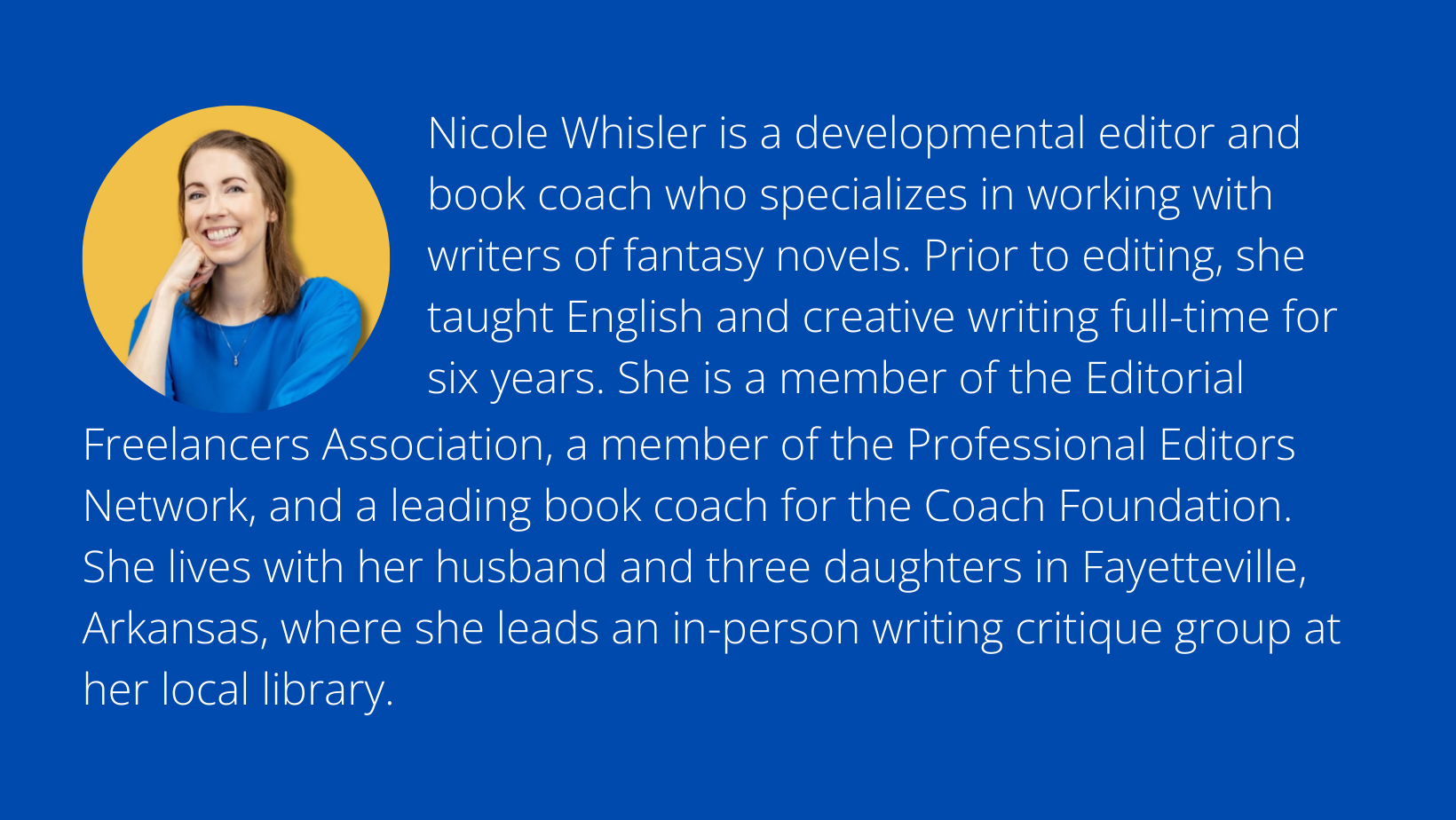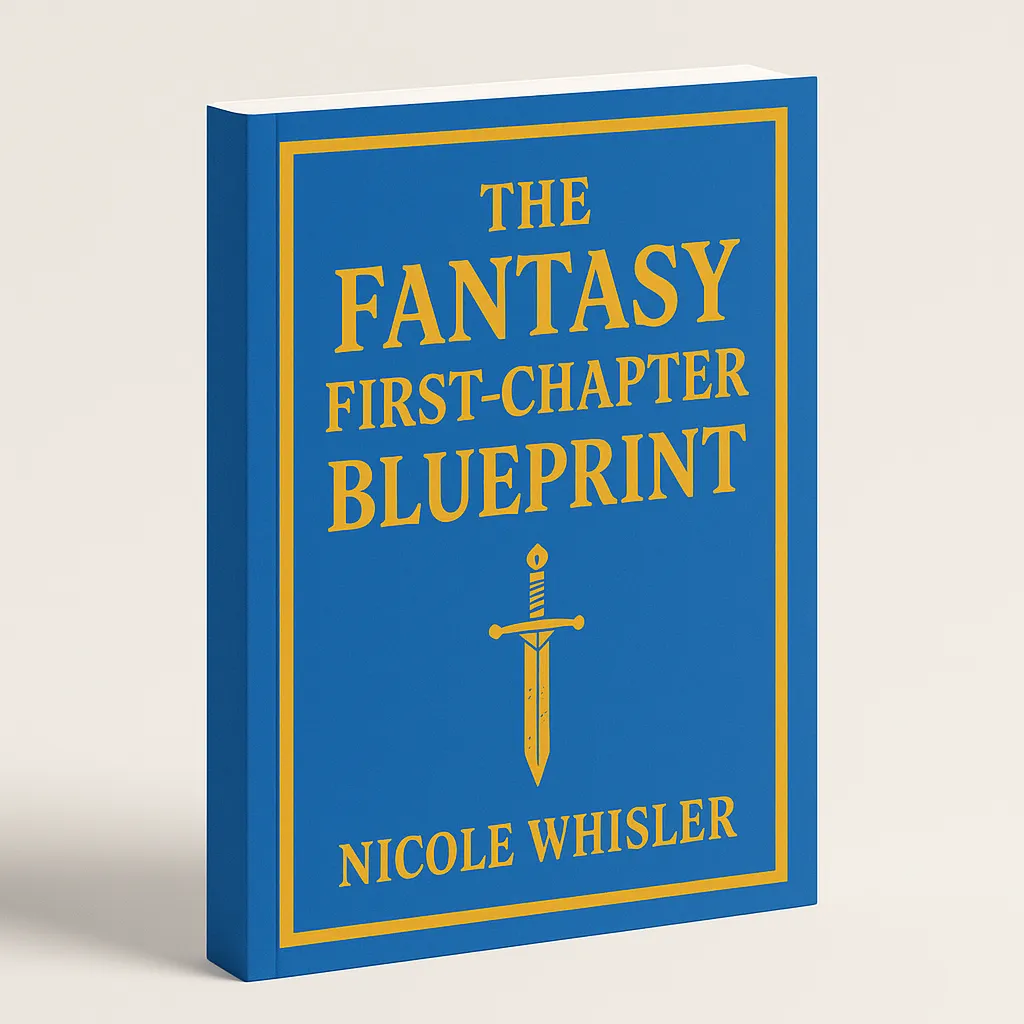The Fantasy First-Chapter Blueprint
Your first chapter is your one shot to hook an agent or a reader. Don't let the 7 deadliest mistakes land your manuscript in the rejection pile. This free 7-day email course gives you the step-by-step blueprint to avoid them and craft an irresistible opening.

Your Novel Matters ...
Looking for the right book coach for your fantasy novel?
Are you a fantasy writer …
… struggling to convert the vivid scenes of your fantasy novel from your imagination to the page?
… stuck in a loop where you constantly rewrite your opening pages?
… worried your story won’t resonate with your readers?
What if I could show you the exact steps week to week that would take you from brainstorming and drafting to revising and publication?
I specialize in developmental editing and book coaching for writers of fantasy novels—writers who value the craft of storytelling and wish to create stories that resonate.
My Services
Develop Your Ideas
Fantasy Footsteps: Road to Publication

I’ll let you in on a secret. All you need to succeed as a writer are three things:
A Roadmap: Illuminate your path with a step-by-step guide, ensuring you achieve your writing goals every week. From outlining to publishing, every stage of your journey is mapped out for success.
Mindset Mastery: Learn how your thoughts control your outcomes in your writing. Overcome self-doubt and unearth the confidence that will bring your unique ideas to life on the page.
Personalized Support: Prepare for comprehensive assistance, real-time accountability, and feedback tailored to your needs. From brainstorming sessions to final publication, you'll have a dedicated ally guiding you every step of the way.
With these three pillars, you'll unlock the potential to:
Craft a captivating story that enthralls readers from the first page to the last.
Develop complex characters and immersive worlds that resonate deeply with your audience.
Navigate the complexities of plot twists and pacing, keeping readers hooked until the final chapter.
Receive specific guidance on refining your scenes so that readers root for your protagonist.
Overcome writer's block and stay motivated throughout your writing journey, ensuring consistent progress.
Transform your rough draft into a polished, professional manuscript ready for publication.
Are you ready to turn your fantasy novel from a mere vision into a masterpiece that captures hearts and minds?
Join Fantasy Footsteps: Road to Publication and begin your author journey with everything you need to write a story that works.
Don't let your story remain trapped in your mind—bring it to life with me!
If you’re thinking, “Yes, please! Tell me what to do!” , I’d like to invite you to work one-to-one with me to finish your novel and write a story that works. Join my book coaching program designed specifically for fantasy writers—Fantasy Footsteps: Road to Publication.

Discover Helpful Tools
Resources For Writers
Here you will find some of my favorite resources for writers.
Add these books, podcasts, websites, and other resources to your writing toolbox to augment your writing at any stage.
Join My Free, Private Facebook Group
Finish My Fantasy Novel: Write & Revise My Best Book in 6 Months
In the group, I go live weekly with writing tips. The group is also a platform for writers to support each other and share their wins and progress.
Live training schedule:
1st Tuesday of the month: Free critique for someone in the group!
2nd Tuesday of the month: Writing sprint with fellow writers
3rd Tuesday of the month: Live training on a specific topic
4th Tuesday of the month: Interview with an author or marketing/business expert


Improve Your Craft
Writing Advice Blog
As a developmental editor and book coach, everything I post is designed to help you build your creativity, strengthen your prose, and explore new avenues in your writing. The opinions in each post are my own, but many are inspired by ideas from established authors and editors who excel in their fields.
Rely on my blog for clear and specific writing advice, motivational tips and grammatical aid, and interviews with experts!
Hi! I'm Nicole.
I’m a Developmental
Editor & Book Coach for Fantasy Writers.
Like you, I'm a writer. I understand the mental and emotional ups and downs of storytelling. Don't let resistance win! Recognize the value of good advice plus hard work.
My approach to novel writing is multifaceted. For a deeper understanding of my process and style, take a look at some of my favorite craft-of-writing books in my Resources section.
What can I say about myself? I read, I write, I read about writing, and I write about reading. It never gets old to me.

See what writers like you are saying . . .

Nadir Shirazi
“I’ve been stalling on my Islam-inspired sci-fantasy series for 10 years. But within 10 minutes of starting Nicole’s program, I started writing again."

Amanda Emerick
“I can’t recommend Fantasy Footsteps enough to writers who are legitimately looking to polish their craft, write, and eventually publish their novel."

Trinity Cunningham
“I loved discussing my story with Nicole. She provided me with invaluable insights I never would have considered on my own."
Latest on the Blog

You will find no pictures of kittens here. No images of favorite dessert recipes, snapshots of my recent vacations, videos of puppies playing the piano (although I do love dogs), or YouTube clips of monkeys stealing people’s sunglasses.
I’m genuinely sorry if that disappoints you.
Instead, you can rely on my blog for clear and specific writing advice, motivational tips, grammatical aid, and author/editor interviews.
As a developmental editor & book coach, everything I post is designed to help you build your creativity, strengthen your prose, and explore new avenues in your writing. The opinions in each post are my own, but many are inspired by ideas from established authors and editors who excel in their fields.
Some of these tips might be just what you need to hear. Others might not work for you personally, and that’s okay.
Apply the tips that fit your personality and writing habits, and feel free to adapt or ignore the others. For further questions and comments, you can email me or reach me through my Contact page.

Designing a Memorable Villain
Discover in this post …
the difference between an antagonist and a villain—and whether morally gray is a better choice than straight-up “evil.”
how to craft a compelling villain that readers love to hate.
how to avoid losing emotional impact with readers when designing your villain.
The Best Villains
Over forty years ago, film critic Roger Ebert claimed that “each film is only as good as its villain.”
Granted, he was speaking specifically about Star Trek and James Bond at the time, but I’ve found that in most cases, a story falls flat without a compelling villain.
Well-designed villains keep readers (and the hero) on their toes, elevate the tension and conflict, drive character development, and leave a lasting impression.
Some of my favorite villains in literature include the Lord Ruler in Mistborn (a tyrant who believes he’s acting for the good of everyone), Annie Wilkes in Misery (a serial killer who forces the protagonist into writing his best book to date), and Hannibal Lecter in The Silence of the Lambs (a polite, eloquent, cannibalistic killer with intelligence and charisma).
It may be easy for you to identify your favorite villains, but have you ever analyzed exactly what makes them so compelling?

Why do we love to hate them? Why do we lean forward, eyes glued to the page, stage, or screen when they enter the scene? Let’s break it down today so that you not only understand what makes these types of villains tick, but also leave knowing how to capture your audience in a similar way in your own story.
Before we get to the meat of this post, though, let’s make sure we’re on the same page with our terminology.
Is an Antagonist the Same as a Villain?
“Antagonist” and “villain,” although related, are not interchangeable terms.
An antagonist (or an antagonistic force, such as “man vs. nature” or “man vs. self”) opposes the hero in some way, whereas the word “villain” is typically associated with some type of evil. Merriam Webster has two primary definitions for villain:
“A character in a story or play who opposes the hero”
“A deliberate scoundrel or criminal”
When we hear the word “villain,” we generally think of a person who is morally corrupt in some major way. That’s the connotation I’ll address in this post, not “man vs. nature” or “man vs. self.” Those are interesting topics, but not relevant to today’s discussion.
We’re about to dive into my recommendations for the best, most memorable villains, but if you can bear with me for another minute, I’d like to respond to one of the top questions I receive about villains:
Is It Better to Write a Morally Gray Villain or a Completely Evil One? Morally Gray Is Trending, Right?
If I were coaching the person who asked this question, I’d begin by asking them to clarify what they mean by “better.” “Better” is a relative term, so I’d want to know more about their personal intentions for their story and characters.
It’s true that morally gray villains have grown in recent popularity, but consider the why behind this trend. Readers admire characters with depth, and diving into the reason someone acts the way they do usually complicates the plot in a positive way. It prompts readers to ask questions: Is that action justifiable? Does that scenario make sense? Would I ever be driven to do that?
Remember that villains are often heroes in their own minds. They believe in the result they’re trying to create. Often, they subscribe to an “ends justify the means” mentality.
So to answer the “morally gray vs. completely evil” question, my opinion is that your villain can be as evil or as morally gray as you’d like, but make sure to include a solid, believable reason for their actions. Are they a sociopath? Did they have a traumatic childhood? Do they have a vendetta against someone who mistreated them in their past?
If you’ve seen the movie Maleficent with Angelina Jolie, you’ll understand exactly why she acts the way she does. The screenwriters gave her a tragic backstory that makes her actions throughout the rest of the story make sense—and even appeal—to viewers. The betrayal she experienced as a young fairy transforms her into a cold-hearted fairy bent on revenge.
And viewers can’t look away.

How Do I Write a Memorable Villain Readers Love to Hate?
Now that we’ve clarified some relevant items, let’s consider what to focus on when crafting a villain readers will remember.
A few years ago, I had an insightful email conversation with screenwriting professor Eric Edson, author of The Story Solution: 23 Actions All Great Heroes Must Take. We were discussing what makes a strong hero, but on the flip side, we found that these same items often applied to the story’s villain. Here’s what Edson said to me:
“I agree that you cannot create a ‘compelling character’ without first making them, to some degree, a ‘sympathetic character.’ Readers connect to characters in a story through subjectively emotional pathways. That’s how you make even arch-villains compelling, by giving them some true human depth including recognizable human motives. And some of the best villains are mirror reflections of the hero or heroine with many of the same qualities except for the villain’s selfishness and moral blindness—while the hero fights them to reach some form of moral justice.”
I love how Edson emphasized that an effective villain is often a mirror reflection of the hero, willing to go to morally questionable lengths to achieve their goal, while the hero is often unwilling to do so. Viewing the hero and villain this way ties these characters together while shedding light on their most fundamental differences.
It’s also a relief for many writers to understand that creating a memorable villain isn’t entirely separate from creating a memorable hero. It means we don’t need to reinvent the wheel. Instead, we can apply the qualities of a likable hero to our villain.
In The Story Solution, Edson proposes that integrating a minimum of five of the following nine traits, as early as possible, will establish a firm connection between readers and your hero (so by extension, we can relate this list to villains as well):
Courage
Unfair Injury
Skill
Funny
Just Plain Nice
In Danger
Loved by Friends & Family
Hard Working
Obsessed
I covered the traits above in much more detail in a past blog post (Crafting a Compelling Character), so take a quick detour to that post if you’d like further explanations of each, along with a specific example.
But other than integrating the qualities from the list above, how do we create a compelling villain?
To answer, let’s compare two of my favorite villains: Annie Wilkes from Stephen King’s Misery and Hannibal Lector from Thomas Harris’s The Silence of the Lambs.
I find Annie Wilkes incredibly compelling and unpredictable. She saves famous author Paul Sheldon (she’s his biggest fan!) after he is severely injured in a car accident, then keeps him captive in her house and forces him to change his current manuscript to her liking. Oh, and she’s also a serial killer. Ironically, Paul writes his best book to date in her company!

Hannibal Lecter, on the other hand, is a brilliant psychiatrist, psychopath, and cannibalistic killer who helps FBI trainee Clarice Starling find and catch another serial killer. Lecter is polite and well-spoken, but even more interesting than his surprising manners is his way of drawing out details from Clarice about her past and her deepest fears.
Both Wilkes and Lecter influence the protagonist in a specific way and even go so far as to help them. Wilkes prompts Paul to write his masterpiece, and Lecter provides clues that lead to Clarice locating a killer. The villains impact the heroes in a vital way, and they both have admirable qualities in spite of their sadistic natures.
But giving your villains sympathetic qualities and ensuring they influence your protagonist in some vital way isn’t always enough to guarantee you’ll reach maximum emotional impact with readers. You’ll also want to avoid some key mistakes writers often make when crafting their villains:
What Should I Avoid When Crafting My Villain?
We’ve looked at some characteristics that make up a memorable villain, but let’s not forget the power of staying far away from some beginner (and even intermediate) mistakes.
*Disclaimer: I believe a writer can pull off anything if done well. As I always say, of course there are exceptions to what I’m about to say! Just be wary of assuming you’re the exception. I’ve seen stories lose their emotional impact all too often when the book includes any of the items I’ve listed below.
Here are some villain-related problems that crop up in the early stages of many manuscripts. Don’t worry if you’re unsure how to resolve these issues at first—I included at least one potential fix for each!
COMMON PROBLEM 1: Your villain is too easy to conquer. They’re not a strong enough threat for readers to ever truly worry your hero will fail. This can lessen the suspense like nothing else! This issue is especially problematic if you’ve built up your villain as someone difficult to defeat, then leave that promise unfulfilled.
SOLUTION: Make your villain formidable! The protagonist should be the underdog; otherwise, all the mystery surrounding who will defeat who will disappear … and so will your readers.
_____________________________
COMMON PROBLEM 2: Your villain doesn’t appear until midway through the book—or sometimes even later.
SOLUTIONS: It’s actually okay if your villain doesn’t appear in person early in the book. To ensure your characters are still adequately threatened, you can follow one (or more) of these paths:
Include “sub-villains” that threaten your protagonist and characters. For example, Voldemort is the main villain of the Harry Potter series, but Snape acts the part for the majority of the first book. In fact, if you look at each of the seven books, you’ll find at least one character who consistently stands in for the greater threat until it’s time for Harry to face Voldemort at the book’s end.
Consider how the villain’s desires and actions affect your characters on the page, even if the villain isn’t seen. How is the villain creating harm? An emperor doesn’t need to be seen to establish a law that makes it illegal for anyone to leave their home after dark. An evil twin doesn’t need to be seen to wreak havoc on his other half’s life. How do these decisions affect the characters? What are the consequences? Showing the impact of these decisions upon the characters can add a layer of depth to your overall story—because the way characters respond to hardship reveals who they are at their core.
Have other characters give a speech in praise of the villain. Set up the villain’s most sinister or powerful qualities by having other characters discuss them. When inserted into natural conversation that fits the surrounding dialogue, this technique can increase the tension by instilling fear in both characters and readers.
_____________________________
COMMON PROBLEM 3: Your villain is a faceless organization instead of a person. This choice doesn’t provide readers a detailed enough picture for them to respond emotionally to whatever is threatening the hero.
SOLUTION: This one’s easy! If an organization presents the main threat, simply include a villain who represents the face of the organization.
_____________________________
COMMON PROBLEM 4: Your villain lacks a clear goal or a clear motivation behind that goal.
SOLUTION: By the end of your story, readers will want to understand why the villain wants what they want. Let your villain’s goals direct the story. Just like you know what your protagonist is doing at any given time in your story, you should also be able to map out the “behind the scenes” moments regarding your villain—moments that will connect directly to your villain’s deepest motives, desires, and fears.
Summing Up
Today I’ve examined multiple aspects of designing a memorable villain. Here’s a quick recap of the key points:
Memorable villains should be believable and three-dimensional. Even if they’re fully evil, they should have clear goals and (especially!) motivations behind those goals.
To some degree, a sympathetic villain often has the same types of traits as a sympathetic hero. (Remember you can view those traits in more detail in my post Crafting a Compelling Character.)
Consider how your villain influences and changes your hero, especially in relation to your hero’s goals or character arc.
Avoid common mistakes when crafting your villain, such as not making your villain formidable enough, not including your villain’s presence until late in the story, or opting for a faceless organization instead of a person.
Hope you enjoyed today’s villain talk! As with any topic, I’ve scratched the surface here, but there’s always more to say. Who are your favorite villains in books you’ve read or movies you’ve seen? What traits did you admire (or despise) most about them? I'd love for you to email me at [email protected] and let me know!
Do you want to learn how to write a story that makes your target readers stand up and cheer? If you’d like support from A to Z (from brainstorming to drafting to revising to publication), book a Discovery Call with me to see if you’re a good fit to join my book coaching program, Fantasy Footsteps: Road to Publication. And if you haven’t done so already, grab your Free Guide on how to hook readers from your story’s start!

Capture Your Readers from Your First Scene
Get my exclusive blueprint—7 Mistakes to Avoid in Your Fantasy Novel’s Opening. Start your fantasy novel right!
Are you worried you've failed to establish a bond between readers and characters in your first chapter? Do you wonder if you've bogged readers down with your worldbuilding? Do you sometimes overlook essential conflicts? Many readers will put your book down if it doesn't grab their attention right away, so it's vital to evoke powerful emotions from readers as early as possible.
Don't let these common mistakes rob your story of its magic and momentum. Save your precious time and energy by ensuring you hook readers from the start. Grab your guide now and check your opening against these common missteps!
(You will also receive monthly writing advice, updates about my free live trainings, and direct access to replays. Unsubscribe anytime.)

